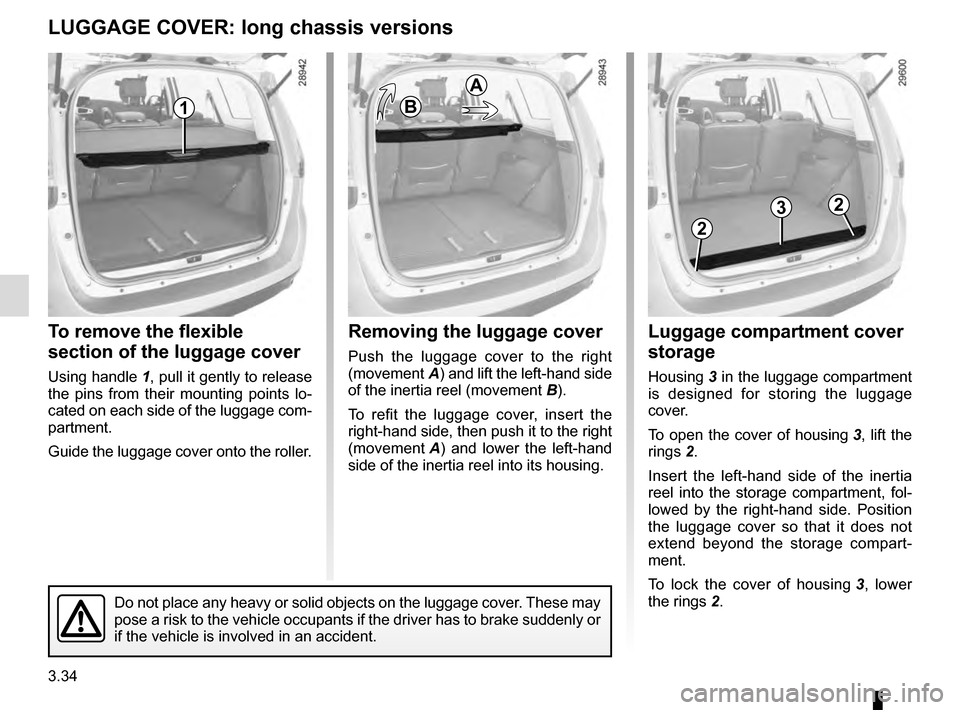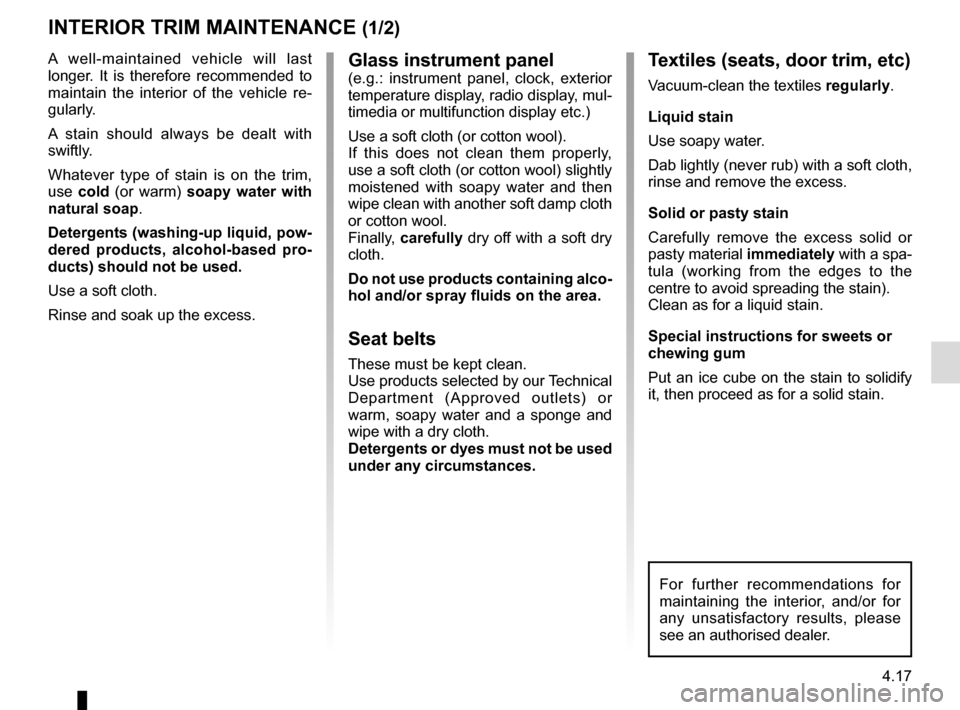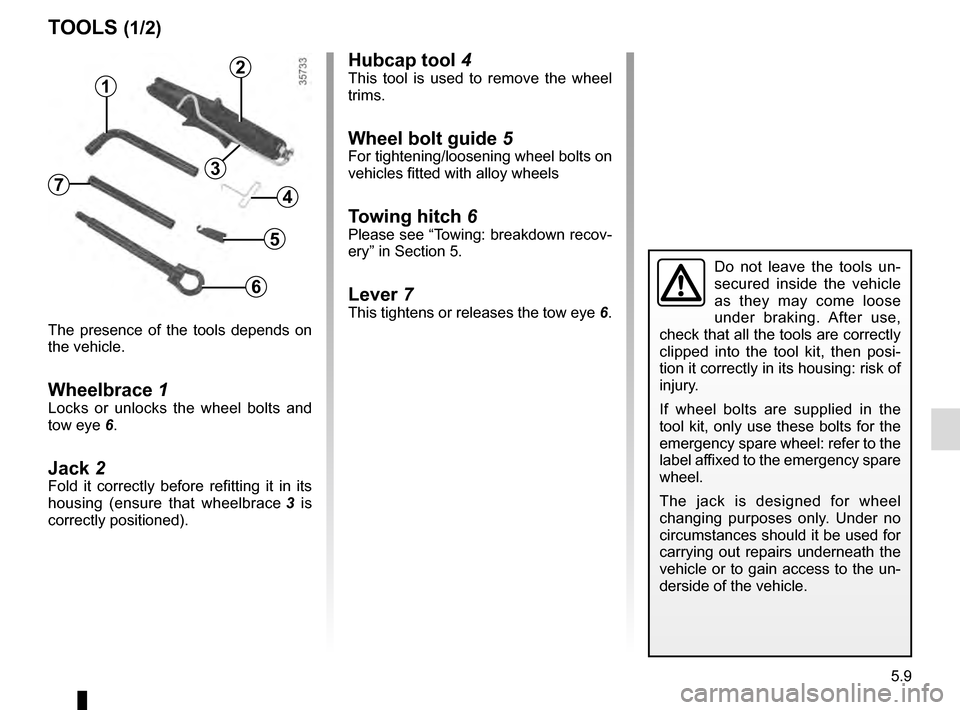Page 170 of 270
3.30
To unfold a seat
– From the luggage compartment, remove the luggage cover and store
it (refer to the information on the “lug-
gage cover: long chassis versions” in
Section 3);
– pull strap 2, lock the seat by pull-
ing on the top of the seatback and
ensure that it is correctly locked in
place;
– fit the headrest.Third row rear seats
Folding up a seat
– From the luggage compartment, lower the headrest;
– pull strap 2;
– push the seatback (areas A) to lock
the seat, ensuring that it is correctly
locked.
Note: the hooks 1 secure the seat belt
buckles.
REAR SEAT OPERATION: 7-seater version (1/2)
When moving third row rear
seats:
– check that no one is near
to any of the moving parts;
– check that there is sufficient space around the seat;
– check that nothing obstructs the section of the luggage compart-
ment reserved for storing the
seat.
For safety reasons, carry out any
adjustments when the vehicle is sta-
tionary.
2
AA
1
2
AA
1
Page 172 of 270
3.32
TAILGATE
13
To open
Press button 1 and lift the tailgate.
To close
Lower the tailgate using the handles 2
inside the tailgate to help you.
Opening the doors manually
from the inside
Special note
If it is impossible to unlock the tailgate,
it can be done manually from inside:
– access the luggage compartment by tilting the rear bench seatback(s),
– insert a pencil or similar object in recess 3 and slide the unit as shown
in the illustration;
– push the tailgate to open it.
2
Page 174 of 270

3.34
Removing the luggage cover
Push the luggage cover to the right
(movement A) and lift the left-hand side
of the inertia reel (movement B).
To refit the luggage cover, insert the
right-hand side, then push it to the right
(movement A ) and lower the left-hand
side of the inertia reel into its housing.
To remove the flexible
section of the luggage cover
Using handle 1, pull it gently to release
the pins from their mounting points lo-
cated on each side of the luggage com-
partment.
Guide the luggage cover onto the roller.
Luggage compartment cover
storage
Housing 3 in the luggage compartment
is designed for storing the luggage
cover.
To open the cover of housing 3, lift the
rings 2.
Insert the left-hand side of the inertia
reel into the storage compartment, fol-
lowed by the right-hand side. Position
the luggage cover so that it does not
extend beyond the storage compart-
ment.
To lock the cover of housing 3, lower
the rings 2.
LUGGAGE COVER: long chassis versions
Do not place any heavy or solid objects on the luggage cover. These may
pose a risk to the vehicle occupants if the driver has to brake suddenly\
or
if the vehicle is involved in an accident.
1B
A
32
2
Page 184 of 270
4.2
BONNET (1/2)Unlocking the bonnet catch
To release it, lift tab 2.
Opening the bonnet
Lift the bonnet; you will need to guide it
as it is held by a strut.
To open, pull handle
1, located on the
left-hand side of the dashboard.
1
2
Do not press down on the
bonnet: there is a risk that
the bonnet may accidentally
close.
The engine may be hot
when carrying out opera-
tions in close proximity. In
addition, the engine cooling
fan can come on at any moment.
Risk of injury.
Before performing any
action in the engine com-
partment, the ignition must
be switched off by pressing
the engine stop button (please see
the information on “Starting, stop-
ping the engine” in Section 2).
When working in the engine
compartment, ensure that
the windscreen wiper stalk
is in the park position.
Risk of injury.
Page 185 of 270
4.3
BONNET (2/2)
Closing the bonnet
Check that nothing has been left in the
engine compartment.
To close the bonnet again, hold the
bonnet in the middle and guide it down,
allowing a 30 cm gap before it is closed,
then release it. It will latch automatically
under its own weight.
After carrying out any work
in the engine compart-
ment, check that nothing
has been left behind (cloth,
tools, etc.).
These may damage the engine or
cause a fire.
Ensure that the bonnet is
properly locked.
Check that nothing is pre-
venting the catch from lock-
ing (gravel, cloth, etc.).
In the event of even a slight
impact involving the radia-
tor grille or bonnet, have the
bonnet lock checked by an
authorised dealer as soon as pos-
sible.
Page 199 of 270

4.17
Glass instrument panel(e.g.: instrument panel, clock, exterior
temperature display, radio display, mul-
timedia or multifunction display etc.)
Use a soft cloth (or cotton wool).
If this does not clean them properly,
use a soft cloth (or cotton wool) slightly
moistened with soapy water and then
wipe clean with another soft damp cloth
or cotton wool.
Finally, carefully dry off with a soft dry
cloth.
Do not use products containing alco-
hol and/or spray fluids on the area.
Seat belts
These must be kept clean.
Use products selected by our Technical
Department (Approved outlets) or
warm, soapy water and a sponge and
wipe with a dry cloth.
Detergents or dyes must not be used
under any circumstances.
INTERIOR TRIM MAINTENANCE (1/2)
Textiles (seats, door trim, etc)
Vacuum-clean the textiles regularly.
Liquid stain
Use soapy water.
Dab lightly (never rub) with a soft cloth,
rinse and remove the excess.
Solid or pasty stain
Carefully remove the excess solid or
pasty material immediately with a spa-
tula (working from the edges to the
centre to avoid spreading the stain).
Clean as for a liquid stain.
Special instructions for sweets or
chewing gum
Put an ice cube on the stain to solidify
it, then proceed as for a solid stain.
A well-maintained vehicle will last
longer. It is therefore recommended to
maintain the interior of the vehicle re-
gularly.
A stain should always be dealt with
swiftly.
Whatever type of stain is on the trim,
use
cold (or warm) soapy water with
natural soap.
Detergents (washing-up liquid, pow-
dered products, alcohol-based pro-
ducts) should not be used.
Use a soft cloth.
Rinse and soak up the excess.
For further recommendations for
maintaining the interior, and/or for
any unsatisfactory results, please
see an authorised dealer.
Page 203 of 270

5.3
PUNCTURE/EMERGENCY SPARE WHEEL (2/2)
B
5
5
To refit emergency spare wheel B
Stand the wheel up with the valve to-
wards you. Pass the cable through the
rim and reposition lock 5. Position the
wheel so that valve 6 is nearest the
ground.
From the luggage compartment, tighten
the bolt fully in order to wind the retain-
ing cable, ensuring that the wheel re-
mains horizontal and the cable taut.
4
3
Emergency spare wheel B
It is located under the vehicle. In the
luggage compartment, lift cover 3 and
remove the blanking cover. Only use
the wheel brace 4 (using a different tool
could damage the mechanism) to unroll
the retaining cable, making sure it re-
mains taut, and the wheel falls to the
ground.
From outside the vehicle, stand the
wheel up, press lock 5 and rotate it
quarter of a turn. Remove the cable
from the rim to release it.
6
As the punctured wheel
is wider than the emer-
gency spare wheel, when
you place the punctured
wheel in the emergency spare
wheel bay, the vehicle’s ground
clearance is reduced. To pre-
vent damage, proceed carefully
when driving over raised sections
of road and when dismounting
pavements When this is fitted to
the vehicle, which must only be
a temporary measure, the driv-
ing speed must not exceed the
speed indicated on the label on
the wheel. Replace the emer-
gency spare wheel as soon as
possible with a wheel with the
same dimensions as the original.
Page 209 of 270

5.9
Hubcap tool 4This tool is used to remove the wheel
trims.
Wheel bolt guide 5For tightening/loosening wheel bolts on
vehicles fitted with alloy wheels
Towing hitch 6Please see “Towing: breakdown recov-
ery” in Section 5.
Lever 7This tightens or releases the tow eye 6.
The presence of the tools depends on
the vehicle.
Wheelbrace 1Locks or unlocks the wheel bolts and
tow eye 6.
Jack 2Fold it correctly before refitting it in its
housing (ensure that wheelbrace 3 is
correctly positioned).
TOOLS (1/2)
Do not leave the tools un-
secured inside the vehicle
as they may come loose
under braking. After use,
check that all the tools are correctly
clipped into the tool kit, then posi-
tion it correctly in its housing: risk of
injury.
If wheel bolts are supplied in the
tool kit, only use these bolts for the
emergency spare wheel: refer to the
label affixed to the emergency spare
wheel.
The jack is designed for wheel
changing purposes only. Under no
circumstances should it be used for
carrying out repairs underneath the
vehicle or to gain access to the un-
derside of the vehicle.
2
1
4
6
5
73